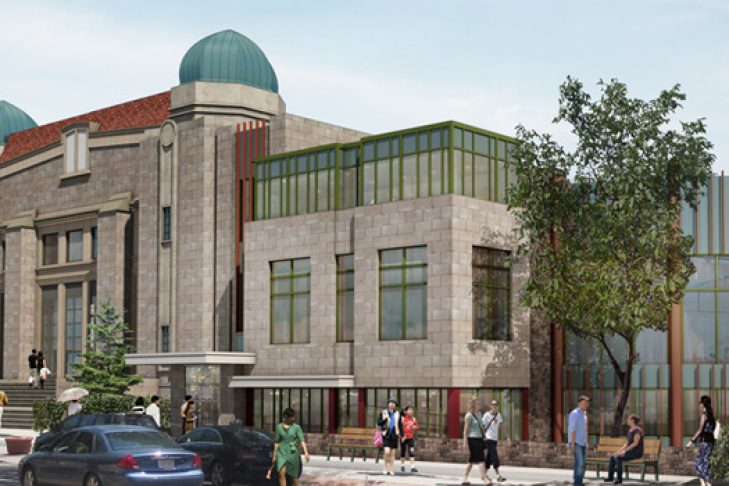The 2015 Greater Boston Jewish Community Study, commissioned by CJP, validates Congregation Kehillath Israel’s strategic transformation from a traditional synagogue model to a multi-generational campus of Jewish engagement. It documents the re-urbanization of the Jewish population, a decline in the number of people identifying with a specific denomination, and the desire for strong engagement with the State of Israel. The study provides new insights as we flesh out our strategy, and challenges us to do our part to help shape the community of the future and to reach a larger audience.
The study’s greatest innovation is an Index of Jewish engagement, which measures concrete behaviors associated with Jewish living, including family holiday celebrations, ritual practices, cultural activities and organizational participation. These behaviors are then used to identify five different groups within the population: Immersed, Cultural, Affiliated, Familial and Minimally Involved. The groupings are meant to be more relevant than the traditional method of describing Jews as Orthodox, Conservative, Reform and Reconstructionist.
The findings of the study provide quantitative support for the “KI Next” approach. In particular:
- The Jewish population of Greater Boston is growing, and after decades of migration to the suburbs, a re-urbanization is occurring, especially among younger adults. That means a growing population near our location in Coolidge Corner.
- KI already does a good job of serving immersed Jews, who are heavily involved in all the main Jewish behaviors, and affiliated Jews, who donate to Jewish causes and pay synagogue dues, but are not regular synagogue attendees. Our partnerships with Center Makor and the Israeli American Council are extending our reach to the cultural segment and may help us reach familial Jews who attend Jewish programs occasionally. These segments include many Russian-speaking Jews and Israelis, who are a significant part of the local population.
- Non-traditional forms of congregations, such as minyanim, are growing. We house three independent minyanim on campus, and are working to collaborate with them more closely on campus-wide initiatives.
- Boston’s Jews have strong connections to Israel. Many have traveled there and seek ongoing engagement. We are strongly committed to broadening and deepening engagement with and support of Israel, especially in the young adult, post-Birthright population.
There were also some new insights, which we need to consider in our plans:
- We are justifiably proud that the campus was brimming with people on the High Holidays, at KI, Congregation Mishkan Tefila and the minyanim. We estimate that more than 2,000 people attended for at least some portion. But with 250,000 Jews in Greater Boston, that means we reached less than 1 percent of the population.
- About 44,000 families are members of synagogues and minyanim, which puts KI’s share in that category at about 1 percent. That should make us feel humble, but it also demonstrates room for substantial growth.
- Re-urbanization is occurring in Brookline, Brighton and Newton. But there is at least as much growth of the Jewish population in Cambridge, Somerville and Central Boston. These growth areas are not as well served by synagogues, and we can consciously include them in our plans, especially since they are easily reachable by public transportation and new modes, such as “pop-up” shuttle services.
- The percentage of Jews identifying themselves as Conservative has declined from 31 percent to 18 percent over the past decade, which shows that standing still is not an option. People are searching for meaning rather than identifying so specifically with a single movement.
We should also use the study to challenge our thinking and spur ourselves to greater ambitions:
- The segmentation of the Jewish population into sub-groups is useful, and we need to meet people where they are. At the same time, people can change, and we should strive to help Jews on their spiritual journey so that fewer land in the minimally involved category and more become immersed. That means investing in our teen and young-adult programming, making it easier for people to explore Jewish rituals and to try out cultural and communal activities. Our brand-new campus teen initiative and young adult task force are tangible steps in this direction.
- One segment not explicitly addressed in the study is Jews by choice. Rabbi Hamilton works with a steady flow of people who were not born into the religion, but who dedicate themselves to becoming Jewish. Their examples can inspire those of us who inherited Judaism to appreciate the richness of our tradition, and underline everyone’s potential to grow Jewishly.
- The study is a snapshot, which documents key trends. However, it does not attempt to predict the future. We shouldn’t let that stop us from peering ahead, anticipating novel institutional structures, leveraging technologies, such as virtual reality and autonomous vehicles, and considering our role at a time of great foment in society.
Congregation Kehillath Israel is currently completing the renovation of the exterior of its main sanctuary and plans to break ground in 2017 on the construction of a new social hall and community space. So far more than 200 donors from KI and the broader Jewish community have contributed funds.
Read the 2015 Greater Boston Jewish Community Study here.
This post has been contributed by a third party. The opinions, facts and any media content are presented solely by the author, and JewishBoston assumes no responsibility for them. Want to add your voice to the conversation? Publish your own post here. MORE



